Rules for watering tomatoes in the open field and in the greenhouse: how often and how much
Despite the fact that tomatoes are a relatively drought-resistant crop, for the full development of which sufficiently dry air is needed, there are certain requirements for watering (and soil moisture) in tomato plants.
Next, we will try to figure out when (how often) and how to properly water tomatoes in the open field and in the greenhouse.
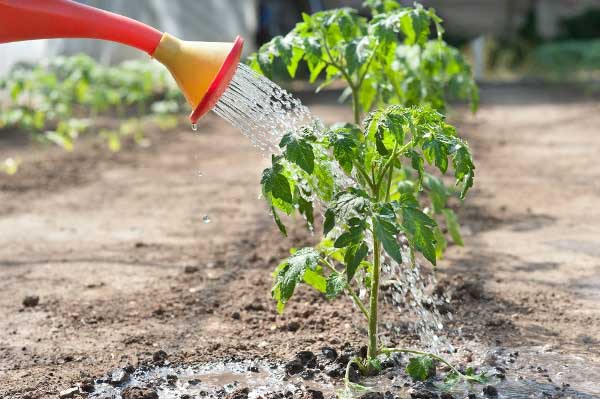
Content
- 1 What is the importance of proper watering of tomatoes
- 2 How to properly water tomatoes: basic tips and tricks
- 3 How to water tomatoes at different stages of development: brief features of watering
- 4 Features of watering tomatoes in the open field and in the greenhouse
- 5 Ways to organize watering of tomatoes: drip irrigation
What is the importance of proper watering of tomatoes
Tomatoes are by no means the most moisture-loving crop, moreover, for a successful existence it needs sufficiently dry air (the plant, in principle, is quite drought-resistant), therefore, watering tomatoes is needed on time and correctly.
Due to lack of moisture, tomatoes will stunted, during flowering can shed ovaries, and during the period of fruit filling, simply will not be able to gain the declared mass (especially large-fruited varieties).
A violation of the preset irrigation regime, namely uneven watering (sometimes dry, sometimes wet, sometimes dry, sometimes wet) will certainly lead to cracking your tomatoes.
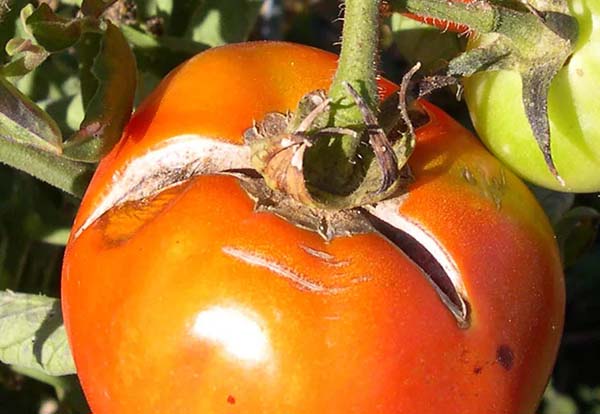
Also, improper watering of tomatoes, namely disadvantage, is the main reason rolling leaves in tomatoes... Due to a lack of moisture, the plant is forced to curl its leaves in order to reduce the evaporation of moisture from their surface.
Actually, in the case of hot and dry air = very low humidity, as well as insufficient watering, curling of leaves will be an inevitable reaction of the plant to a lack of moisture.
This is especially true when growing tomatoes in a greenhouse.

In the same time with excessive watering during ripening and the color of the fruit they can excessively take a long time to ripen and / or become watery (do not pick up sugar).
Important! Besides, increased soil and air moisture are a favorable environment for the reproduction of fungal diseases, i.e. for the flash of the same phytophthora.
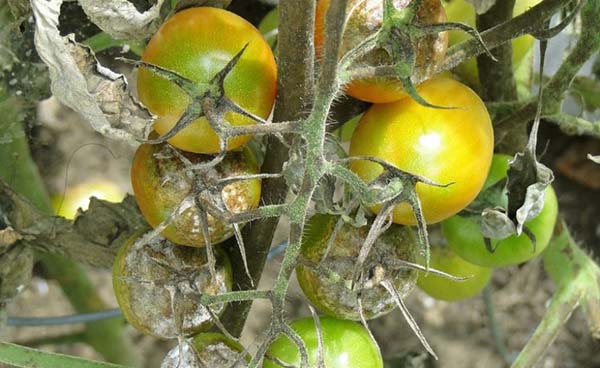
Thus, proper watering is the key to obtaining a high-quality tomato harvest.
Memo! Optimal conditions for the successful cultivation of tomatoes, in which the tomatoes will grow well and bear fruit abundantly:
- air temperature - + 23-28 degrees during the day and not lower than + 15-20 degrees at night;
- air humidity - 50-60%;
- soil moisture - 70-80%.
By the way! The site has a detailed article about the rules for growing tomatoes in a greenhouse.
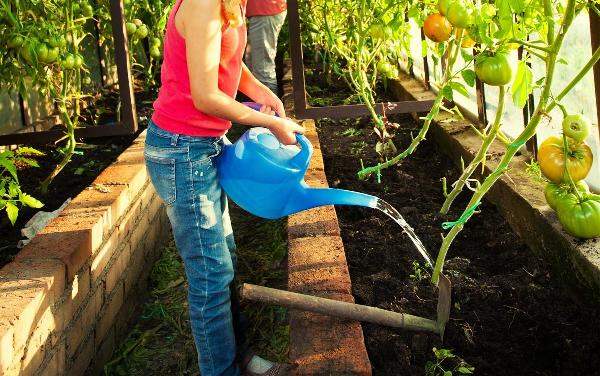
How to properly water tomatoes: basic tips and tricks
It is necessary to water the tomatoes in compliance with certain rules, which are often ignored by novice gardeners, which subsequently always negatively affects the fruiting of the bushes.
And sometimes improper watering and at all is cause appearance late blight (the most dangerous and harmful disease of tomatoes).
Next, we will analyze all the main questions regarding the rules and norms for watering tomatoes in the open field and in the greenhouse.
What time of day is it better to water
- Most gardeners agree that tomatoes should be watered in the morning (in the morning, if hot day or before lunch, if weather worth cloudy ).
- In the evening the same tomatoes watering is not recommended.
Important! The fact is that in the absence of sunlight, the processes of photosynthesis do not occur in plants, which means that the normal development of bushes and fruits is simply disrupted (one of the reasons cracking tomatoes).
But even worse: when you water in the eveningthen you have the humidity in the greenhouse rises, and at night the temperature will inevitably drop. At the same time, high humidity and low temperatures are an excellent environment for the development of fungal diseases such as late blight and powdery mildew.
- On the other hand, there is an opposite opinion (that water better in the evening): after the morning watering, the plant begins to absorb moisture, opens, i.e. begins to live, and then the sun comes out with its scorching rays ...
However, this (negative effects of morning watering) more relevant for warm southern regionsthan for the Middle Lane or more northerly places.
- And here water tomatoes in the afternoon in the heat - anyway Not recommended!
Not only does the water evaporate quickly, and the ground is immediately covered with a crust, but also numerous sunburns can remain on the leaves.
It's another matter if cloudy day. However, in this case too watering better to spend before lunch or late afternoon (in the southern regions).
Thus, if you have cold nights (strong temperature drops), then you need to water either in the morningor in the morning (if cloudy). If you are a resident of a warm southern region, then, of course, it is better to water in the evening.
By the way! In principle, it is allowed to water the tomatoes in the evening (at 17-20 hours) in the open field, as well as in the greenhouse, if after that you thoroughly ventilate it.
What water to water: can it be cold
Both in the greenhouse and in the open ground, warm water should be used for irrigation (at least - 18 degrees, optimally +20 .. + 22 degrees).
Ideally, the water temperature will be as close as possible to the soil temperature.
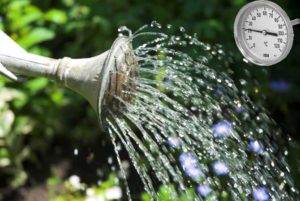
Note! When they say "warm", this does not mean at all that the water needs to be specially heated somehow.
Another thing is that ice water from a well or well In no case should you water the tomatoes.
It will be quite enough if your container of water (barrel, bath) just stands outside and heats up in the sun during the day (towards evening).
But this, with regards to the evening watering, which is done mainly in the warm southern regions!
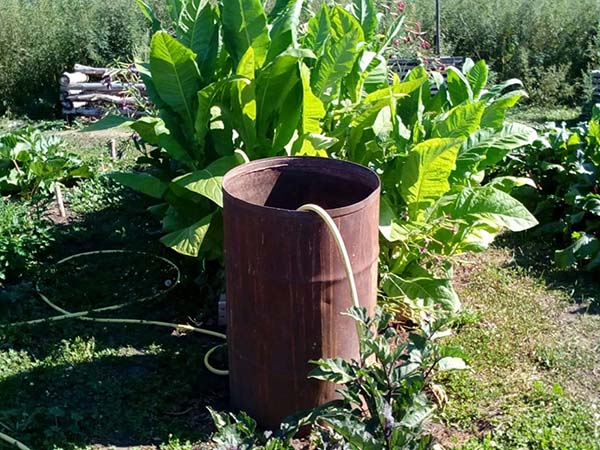
However, it is quite obvious that in the morning, even in barrels, the water will be cold. What to do in this case?
Idea! If you want the water in the barrel to always be warm, then the barrel can be placed in the greenhouse (it will also keep the greenhouse warm at night).
If there is no room in the greenhouse or the barrel is outside, then you can make a "thermos" by placing the barrel in a polycarbonate box. The water in such a "thermos" will cool for a long time and by the morning it will still be quite warm.
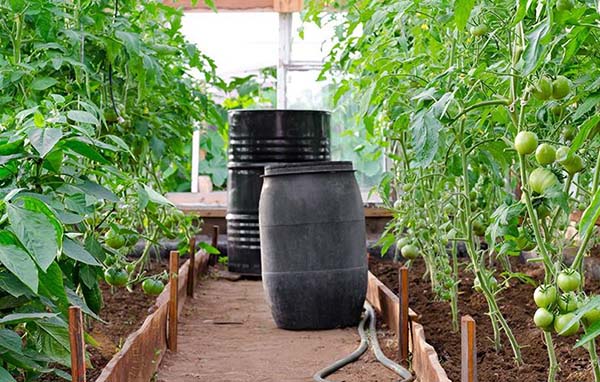
By the way! If the weather is hot and your country water from a hose is + 18-20 degrees, then this is a perfectly suitable temperature for watering tomatoes.
And of course, watering is always better. separated water (naturally, it will always be separated from the container).
How often to water and how much water is needed
As you've probably already noticed, tomatoes are slightly different from cucumbers when it comes to watering. The fact is that tomatoes - where to less moisture-loving plants, so you need to water them less often, but more abundantly than cucumbers.
Frequency and rates of watering tomatoes in the open field and in the greenhouse:
- The main rule: it is recommended to water tomatoes abundantly, but infrequently.
Advice! Although you can do it in smaller volumes, but more often. In this case, it is important to immediately determine the watering regime.
If you constantly change the watering mode (sometimes very dry, sometimes wet) tomato will simply crack.
- The frequency of watering is once every 3-7 days, depending on the growing conditions (less often in the greenhouse, more often in the open field), the weather (hot - more often, cool - less often) and soil composition (if you have sandy soil, then water will have to be more often, but on clay soils with irrigation, you need to be careful).
Advice! You can visually determine the need for watering tomatoes, i.e. according to the condition of the bushes: as soon as the leaves drop slightly and slightly droop, it is time for the next watering.
- The watering rate for tomatoes is 2-10 liters (on average 4-6 liters) per plant, depending on its size (undersized ones require less moisture, tall ones - more) and the stage of development (at the beginning of the growing season - less, during the period of growth and filling - more, ripening and coloring of fruits - again less). Those. on a bed where 10-12 plants grow, an average of about 40-60 liters is used.
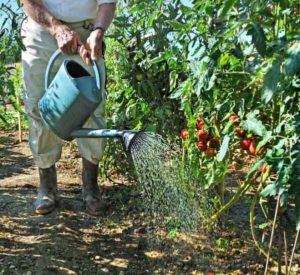
Advice! To determine that the soil is sufficiently moist and there is no need to water yet, you can as follows: take a little at a depth of 10 cm earth (handful) in hand and squeeze lightly - if the ground was stuck, wherein the earthen lump does not fall apart and moisture does not ooze from it - ideal (this the main criterion for proper watering); if the soil does not stick together and crumbles or water flows out of it, you are underfilling or overflowing your tomatoes.

Video: how to water tomatoes correctly - different options
Irrigation technique
Watering tomatoes must be strictly under the root every bush without falling on the leaves. Alternatively, you can still water along the groove (it is more comfortable).
Note! If large drops of water fall on the foliage, then in hot and sunny weather this will certainly lead to the formation of sunburn on them.
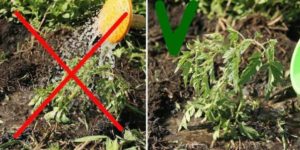
Besides, moisture on the leaves during the cool period can cause the development of a fungal disease such as late blight.
Other recommendations and tips for proper watering of cucumbers in the open field and greenhouse:
- After each watering, it is necessary to carry out the next (after 1-2 hours, when the moisture is completely absorbed) shallow (surface) loosening the soil at the base of the plant (of course, if the bed is not mulched), so that prevent dry crust formation and improve oxygen access to roots.
If this is not done, air will not flow well to the roots of the plant, which in the future will negatively affect its yield.
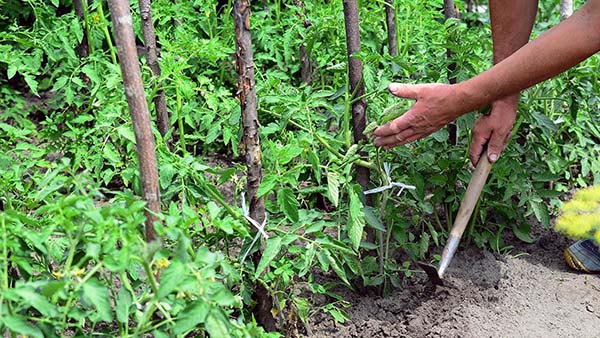
Advice! If you do not want to do frequent looseningthen just mulch your tomato plantings, so you can reduce the number of waterings, because mulch will not allow moisture to evaporate quickly and the soil will stay moist longer.

How to water tomatoes at different stages of development: brief features of watering
As the tomato bushes grow and develop their watering should also change.
As a rule, tomatoes are watered according to the following scheme:
- At the beginning of the growing season (from planting to flowering), it is enough to pour 2-3 liters under one bush (the approximate soil moisture should be about 70%).
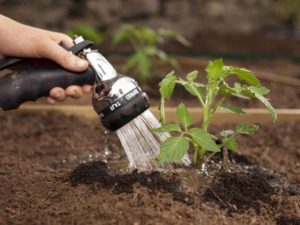
- With the beginning of flowering and filling (increase in size) of the fruits, watering will need to be increased by 2-3 times, i.e. up to 5-10 liters (the approximate soil moisture should already be about 80%).
Important! Lack of moisture during the flowering period can provoke shedding of flowers, and during the pouring of fruits, tomatoes simply cannot gain weight.
- When the tomatoes begin to ripen and turn red, the watering rate should be halved (up to 3-5 liters), otherwise the tomatoes will ripen longer and become watery.
Proven by experience! The less moisture the tomatoes receive when pouring, the sweeter they are. Moreover, excessive watering can cause cracking fruit.
However, it should be understood that in no case should you refuse to water at all during this period.
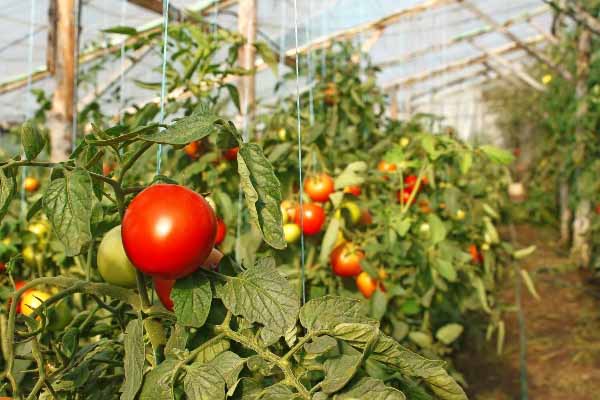
Video: how often and how much to water tomatoes
Features of watering tomatoes in the open field and in the greenhouse
Of course, when growing tomatoes in a greenhouse or in the open field, the specificity of watering plants will differ, but only slightly.
Main advantage growing tomatoes in a greenhouse - this is the ability to independently control both the humidity mode and the temperature, which can be regulated by ventilation.
But it is much more difficult to control soil moisture and even more so air in open ground, because everything depends primarily on weather conditions.
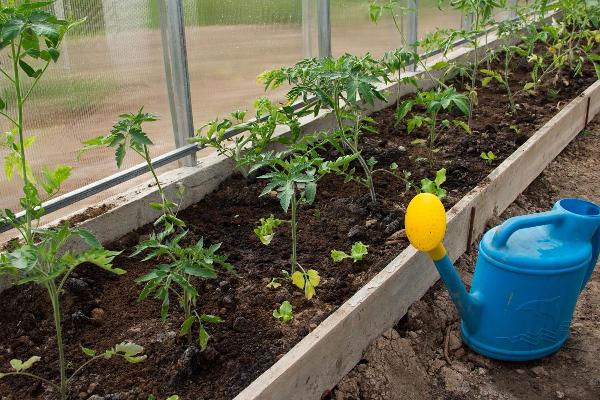
Thus, the main differences and nuances of watering tomatoes in the open field and in the greenhouse are as follows:
- In greenhouse conditions, moisture does not evaporate from the soil as quickly as under the open sun, which means that watering tomatoes growing in a greenhouse should be less oftenthan outdoors (it's another matter if it rains frequently, then ..).
- In no case do not close the doors and vents in the greenhouse after watering, opposite, after each application of moisture, you need ventilate greenhouse room to lower the humidity.
Moreover, do not close the greenhouse after the evening watering!
- If front another watering tomatoes in the open field established cloudy weather (rain is expected), it is recommended to verify its actual need. Thanks to this approach, plants can be protected from waterlogging in the event of prolonged and excessively heavy rainfall.
Ways to organize watering of tomatoes: drip irrigation
To facilitate the procedure for watering tomatoes, it is necessary to apply certain methods that allow you to provide plants with moisture, but at the same time save the strength and time of the gardener. As you guessed it, we are talking about drip irrigation.
Drip irrigation of tomatoes can be used both in the open field and when growing tomatoes in a greenhouse.
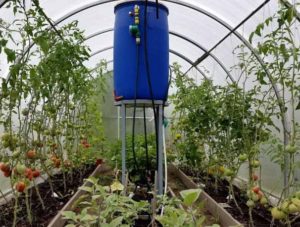
By the way! The principle of drip irrigation of almost all plants (including tomatoes) is often, but little by little.
Ready drip irrigation
Perhaps this is the most effective, but quite costly method of watering tomatoes.
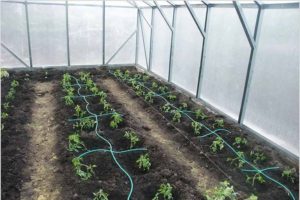
Moreover, the drip irrigation system can either be bought ready-made or built yourself, with your own hands.
By the way! There are several drip irrigation systems:
- drip tape;
- pencil type (polish 64).
For more details about each, see the video below:
Video: drip irrigation for tomatoes - installation
Homemade drip irrigation (plastic bottles)
This method is also a simplified version of drip irrigation. So, many gardeners often use plastic bottles (one and a half or five liters) as homemade drip irrigation, in which it is required to make several small holes through which moisture will pass. Then bury the bottles with the neck down, half in the ground, directly near the bush. This will allow for uniform watering of the tomatoes without increasing humidity in the air. 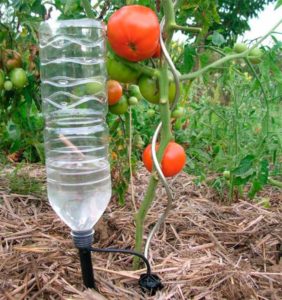
Video: watering system for tomatoes using a plastic bottle
Thus, now you know when (how often) and how to properly water tomatoes in the greenhouse and in the open field, so that in the end you get a harvest of sweet and large tomatoes. Remember that a violation of the watering regime will certainly entail negative consequences for your plants and the quality of their fruits.
Video: proper watering of tomatoes - when and how to water tomatoes


Thanks for the article, I received very valuable information for myself. I especially liked about drip irrigation, well, I learned some of the nuances when watering tomatoes.